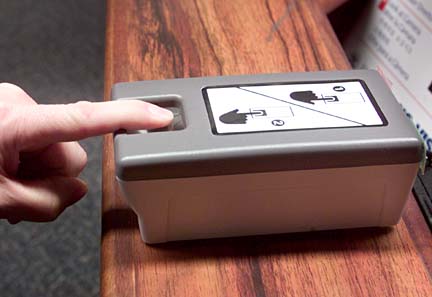
DEAN SENSUI / DSENSUI@STARBULLETIN.COM
Immigration inspector Nicole Thompson demonstrated an ID station on US-VISIT trainer David Austin yesterday at Honolulu Airport. The ball camera takes a photo for quick visual reference.
Program tightens
immigration securityHonolulu and Kona are among
airports using new scanners
About 1,500 of the 6,000 passengers who arrive daily from foreign countries at Honolulu Airport are required to submit to U.S. immigration screening for digital finger scans and facial photography.
Visitors from countries participating in the Visa Waiver Program are exempt from the homeland security process, including Japan, New Zealand and Australia. Passengers on flights from Canada must be pre-cleared prior to boarding planes, although Canadian citizens are also currently exempt from the program.
But many passengers on flights arriving from Korea, the Philippines and China are subject to the program.
"Korean people are really, really mad," said Kyong Ha, a travel agent with Koreana Tour Service. "Some say (they will) never come again to Hawaii."
She said Koreans view being fingerprinted and photographed as something to which "bad people" are subjected. The visitors are further angered that Koreans and Chinese, but not the Japanese, are being fingerprinted and photographed, Ha said yesterday.
By the end of the year, all foreign passengers holding nonimmigrant visas will have to be screened, U.S. Customs and Border Protection Director Peter Gonzalez said. The program later will require foreign travelers departing Hawaii to undergo the process.
DEAN SENSUI / DSENSUI@STARBULLETIN.COM
A device on the counter scans a fingerprint for biometric comparison.
But there are no plans to require U.S. citizens and resident green-card holders to enroll.
The U.S. Department of Homeland Security initiated the US-VISIT system Monday at 114 U.S. international airports, including Honolulu and Kona, and 14 cruise vessel passenger terminals.
"This is part of a new program in the new war against terrorism," Gonzalez said. "The US-VISIT program will help us focus on the at-risk traveler while facilitating the entry of people who pose low risk."
The high-tech system uses biometrics, which measures physical characteristics used to identify a person and compares them with features on a photograph.
The program requires customs officers to scan right and left index fingers to capture digital fingerprints and digitally photograph a person's face, as well as scan a passenger's passport.
The data are submitted by computer to a central database in Washington, D.C., where it is also stored, and within seconds a response is received as to whether a person has a record of criminal history and whether the data match what is in the database.
The individual's photograph is also retrieved, and the officer can make a visual match.
The system will help an officer check for forged passports and bogus visas, Gonzalez said.
He said there have been no glitches with the system so far.
About 50 overseas U.S. consulate offices are collecting the fingerprints and digital photos when individuals apply for visas.
Gonzalez acknowledged that the procedure may be considered an invasion of privacy because it is intrusive, but said the requirement is important to know who is entering and leaving the country.
Officials had no estimates of how long visitors had to stand in line to be fingerprinted and photographed.

